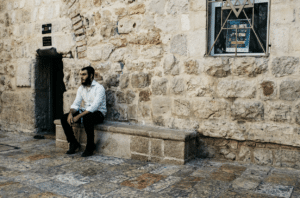It sure seems like Jesus was having a bad day when he marched down to cause mayhem in Jerusalem by turning tables in the temple, blasting a fig tree along the way. Was he just in a foul mood? Did he get up on the wrong side of the bed? Why curse a tree? What was going on there?
It’s easy to miss it, but I think we are given a clue in one particular verse. We can discover that far from being random or impulsive, every word and deed of Jesus was delivered with precision and intent.
The backstory: What happened on Palm Sunday
So here’s what happened according to Mark. Jesus had three times now explained to His disciples that He would suffer, die and rise again on the third day. The first time, Peter rebuked Him, but Jesus was having none of it. The second time, they just didn’t understand and were too afraid to say anything. The third time came as Jesus went ahead of them, leading the way to Jerusalem and certain death. They couldn’t believe it.
“And they were on the road, going up to Jerusalem, and Jesus was walking ahead of them. And they were amazed, and those who followed were afraid”.
“What is he doing?” They must have been thinking, because for them (and let’s face it, for most of us) if there’s a chance to escape crucifixion, we’ll take it. But not Jesus. He reinforced with certainty the plan:
“Look, we are going up to Jerusalem, and the Son of Man will be delivered over to the chief priests and the scribes, and they will condemn him to death and deliver him over to the Gentiles. And they will mock him and spit on him, and flog him and kill him. And after three days he will rise.”
This is not a man who is not prepared for what’s coming. He sees it, he is ready for it, and He shows no fear. He has made up his mind, and is resolute. John 13 lets us in on His secret:
“Knowing that the Father had given all things into his hands, and that he had come from God and was going back to God…”
Jesus knew for sure that this would ultimately turn out very well. He knew it was all in hand, and that He would end up safe at the Father’s right hand—not only delivered from evil and death, but sitting in victory over it. This is the context of what happens next. So in Mark chapter 11, Jesus and His disciples make their way to God’s chosen city, and holy temple. At this point, He is well received, and is warmly welcomed by the people to cries of “Hosanna!, Blessed is He who comes in the name of the Lord!” Then comes the critical verse:
“Jesus went into Jerusalem and into the temple. So when He had looked around at all things, as the hour was already late, he went out to Bethany with the twelve.” (Mark 11:11)
He went to the temple and “looked around at things”? What things?
Then they went to Bethany and went to bed. Jesus had taken in what he had seen, and slept on it.
Fig tree cursing and table turning
It was the next morning that it all kicked off. They were walking back into Jerusalem from Bethany, and Jesus was hungry.
“Seeing in the distance a fig tree in leaf, he went to see if He could find anything on it. When he came to it, he found nothing but leaves, for it was not the season for figs. And He said to it, “May no one ever eat fruit from you again.” And his disciples heard it.”
Then they got to the city, and went into the House of God.
“He entered the temple and began to drive out those who sold and those who bought in the temple, and He overturned the tables of the money-changers and the seats of those who sold pigeons. And He would not allow anyone to carry anything through the temple. And Hhe was teaching them and saying to them, “Is it not written, ‘My house shall be called a house of prayer for all the nations’? But you have made it a den of robbers.” And the chief priests and the scribes heard it.”
We can clearly see that Jesus is a man who knows what is going to happen. He has predicted his death and resurrection three times. We know that he regularly prayed during the night, or when it was still dark, and that He was not the kind of guy to skip on quality time with God. He assures us that he only does things that He sees his Father doing. He is unafraid of people or death, and unswayed by man’s applause.
After the Triumphal Entry, Jesus had gone into the temple and seen all the commercialism and defilement of the temple the day before. He just looked. He saw it all. He did not say a word, much less take any impulsive action. He absorbed the information and went to bed.
He almost certainly talked it over thoroughly with His Father.
Then the day broke.
Figs as a picture of Israel
First, the fig tree incident. The fig in several places is analogous to Israel—consider Nathaniel sitting under a fig tree, and Jesus calling him “a true son of Israel”. God also used figs as a metaphor for the people of Israel and their spiritual state in the book of Jeremiah, contrasting figs were of the finest quality, ripe and ready to eat with figs that were rotten, so rotten they couldn’t be eaten…
“This is the Message from the God of Israel: The exiles from here that I’ve sent off to the land of the Babylonians are like the good figs, and I’ll make sure they get good treatment. I’ll keep my eye on them so that their lives are good, and I’ll bring them back to this land. I’ll build them up, not tear them down; I’ll plant them, not uproot them. And I’ll give them a heart to know me, God. They’ll be my people and I’ll be their God, for they’ll have returned to me with all their hearts.” (Jer 24:1-7)
So here was a tree all leafy and looking to be full of promise, but with no fruit. Usually the fruit comes even before the leaves, so plentiful leaves should normally indicate the presence of fruit, even though it was rather early in the year to find any. Charles Spurgeon said that,
“The blighted fig tree was a singularly apt simile of the Jewish state. The nation had promised great things to God. When all the other nations were like trees without leaves, making no profession of allegiance to the true God, the Jewish nation was covered with the leafage of abundant religious profession… Their constant cry was, “The temple of the Lord, The temple of the Lord, The temple of the Lord, are these”… They were a fig tree in full leaf. But there was no fruit upon them; for the people were neither holy, nor just, nor true, nor faithful towards God, nor loving to their neighbour. [They were] a mass of glittering profession, unsupported by spiritual life.”[1]
The tree was a picture of the religious leadership and what the temple system had descended into. All leaves and no fruit. No sustenance for the spiritually hungry. Just like John the Baptist warned the Pharisees and scribes who came to him in false repentance:
“Do not presume to say to yourselves, ‘We have Abraham as our father,’ for I tell you, God is able from these stones to raise up children for Abraham. Even now the axe is laid to the root of the trees. Every tree therefore that does not bear good fruit is cut down and thrown into the fire.” (Matthew 3:9-10)
Jesus had come to do a new thing. The fruitless tree was about to be destroyed—the temple would be brought to rubble and Israel would be scattered. Jesus promised to destroy it and raise it again in three days—God was going to make his home in the very lives of His people, thanks to the cleansing power of our Messiah’s blood to make us holy. Holy enough to host the Shekinah Glory. It was in this understanding that Jesus cursed the fig tree and then turned things upside down in the temple.
His actions were planned
Jesus had all night to contemplate and pray into the ramifications of going ballistic in the temple. He would also know for sure that there would be questions asked, and that answers would be required. But as we have said, this was no spur of the moment decision, and he was ready with an excellent response.
They demanded,
“By what authority are you doing these things, or who gave you this authority to do them?”
Jesus responded, “I will ask you one question; answer me, and I will tell you by what authority I do these things. Was the baptism of John from heaven or from man? Answer me.”
That scuppered them. Jesus had them either way.
“If we say, ‘From heaven,’” they reasoned, “he will say, ‘Why then did you not believe him?’ But shall we say, ‘From man’?”—they were afraid of the people, for they all held that John really was a prophet. So they answered Jesus, “We do not know.” And Jesus said to them, “Neither will I tell you by what authority I do these things.”
He had every authority to do what He did. “The first Adam came to the fig tree for leaves, but the Second Adam looks for figs”, notes Spurgeon. Jesus always knows exactly what He is doing, and He is slow to anger—always merciful and longsuffering. He never once lost control of his temper. Far from displaying unbridled wrath, He courageously defied the authorities under the authority of God, and provided us all with an escape from wrath as He continued on towards Calvary.
[1] “The Withered Fig Tree”, Sermon (No. 2107) Delivered on Lord’s-day Morning, September 29th, 1889, by C. H. SPURGEON, at the Metropolitan Tabernacle, Newington
Photo by Joash Castro on Unsplash















